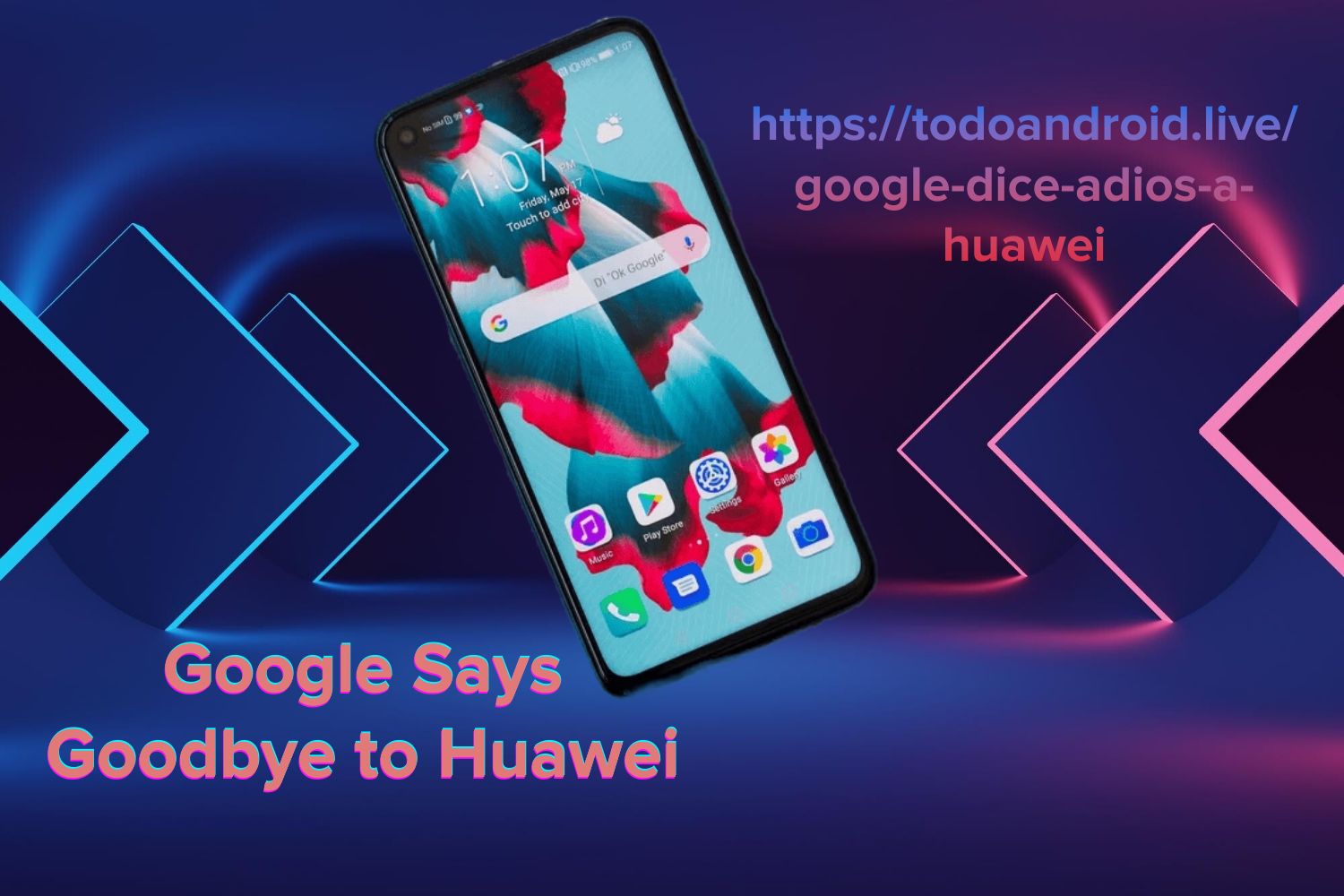Google Says Goodbye to Huawei: What It Means for the Future
In a significant shift in the tech world, Google has announced that it is severing its business ties with Huawei, a decision that reverberates across the global technology landscape. This move is not just a headline; https://todoandroid.live/google-dice-adios-a-huawei, manufacturers, and the broader geopolitical landscape. This article delves into the Google says goodbye to Huawei, exploring its impact on various stakeholders and what the future might hold.
The Background: A Brief Overview
To understand the gravity of Google’s decision, we need to first look at the context. Huawei, a Chinese multinational technology company, has been a major player in the global smartphone market. Known for its innovation and competitive pricing, Huawei quickly ascended to become one of the top smartphone manufacturers in the world. Google, the tech giant behind Android, has been a crucial partner in this journey, providing the operating system that powers Huawei’s smartphones.
However, the relationship between Huawei and Google has been strained for some time. The U.S. government, citing national security concerns, placed Huawei on a trade blacklist in 2019. This blacklist, officially known as the Entity List, restricted American companies from doing business with Huawei without special approval. As a result, Google had to suspend its business dealings with Huawei, cutting off the provision of its popular services and applications.
The Recent Developments
The latest announcement from Google about parting ways with Huawei marks a new chapter in this ongoing saga. This decision has been driven by a combination of regulatory pressures, security concerns, and shifting market dynamics. Google’s decision to end its partnership with Huawei affects several aspects:
- Software and Services: Google’s Android operating system, which Huawei’s smartphones run on, will continue to be available, but Google’s proprietary services, such as the Play Store, Google Maps, and Gmail, will no longer be accessible on new Huawei devices. This creates a significant challenge for Huawei, as its devices will lack the integration and apps that many users rely on.
- Hardware Innovations: Huawei has been known for its cutting-edge hardware. The company’s smartphones have often set new benchmarks in terms of performance, camera technology, and design. However, without Google’s support, Huawei may face challenges in maintaining its competitive edge in the global market.
- Consumer Impact: For consumers, this move could mean a shift in their smartphone experience. Huawei users might need to find alternative apps and services, which could affect their overall satisfaction and usability.
The Geopolitical Implications
The decision to cut ties with Huawei is not merely a business move; it has significant geopolitical implications. The U.S.-China trade tensions have been a backdrop to this decision, reflecting broader issues of technological and economic competition between the two superpowers.
- Tech War: The severance of ties between Google and Huawei is a symptom of the ongoing tech war between the U.S. and China. This conflict extends beyond Huawei and involves various aspects of technology and trade. The restrictions on Huawei can be seen as part of a broader strategy to limit China’s influence in critical technology sectors.
- Global Supply Chains: Huawei’s position as a major player in the global tech supply chain means that changes in its business relationships can have ripple effects across the industry. Companies that rely on Huawei’s technology, whether for hardware components or software solutions, may face disruptions or be forced to find alternative suppliers.
- National Security: The U.S. government’s stance on Huawei is rooted in concerns about national security. The allegations that Huawei’s technology could be used for espionage have been a central issue. Google’s decision aligns with these concerns and reflects a cautious approach to protecting sensitive data and infrastructure.
Huawei’s Response and Future Outlook
In response to Google’s decision, Huawei has been proactive in seeking alternatives and adapting to the changing landscape. Here’s how the company is positioning itself:
- Developing Alternatives: Huawei has been working on its own operating system, HarmonyOS, as a potential replacement for Android. The company is also developing its own app ecosystem, AppGallery, to reduce reliance on Google’s services. While these efforts are in their early stages, they represent a strategic move to regain control over its software and services.
- Strengthening Relationships: Huawei is forging new partnerships with companies and governments outside of the U.S. to expand its market presence. diversifying its network of partners and suppliers, Huawei aims to mitigate the impact of the trade restrictions and maintain its global footprint.
- Innovation and Diversification: Beyond smartphones, Huawei is investing in other technology areas such as 5G, cloud computing, and artificial intelligence. This diversification helps the company remain competitive and relevant in an evolving tech landscape.
Impact on the Global Technology Market
The severance of ties between Google and Huawei will undoubtedly have significant impacts on the global technology market:
- Increased Competition: The absence of Google’s services on Huawei devices opens the door for other tech companies to fill the gap. Competitors in the smartphone and app markets may see new opportunities as Huawei seeks alternative solutions.
- Consumer Choices: For consumers, the lack of Google’s services on Huawei devices means they will have to navigate a new ecosystem. This could influence their purchasing decisions and affect their overall satisfaction with Huawei’s products.
- Regulatory and Trade Dynamics: The decision reinforces the importance of regulatory and trade policies in shaping the technology sector. As governments and companies navigate these complex issues, the technology landscape will continue to evolve in response to geopolitical and economic factors.
FAQs about Google’s decision to sever ties with Huawei
1. Why is Google ending its partnership with Huawei?
Google is ending its partnership with Huawei due to geopolitical tensions between the U.S. and China. The U.S. government placed Huawei on a trade blacklist, restricting American companies from doing business with Huawei without special permission. As a result, Google can no longer provide its services to Huawei devices.
2. What does this mean for Huawei users?
Huawei users will no longer have access to Google’s suite of services, including the Google Play Store, Gmail, and Google Maps. New Huawei devices will not come with pre-installed Google apps or receive updates through the Play Store.
3. How will Huawei replace Google’s services?
Huawei is focusing on developing its own operating system, HarmonyOS, and its app store, the Huawei AppGallery, to replace Google’s services. The success of these alternatives will depend on their ability to attract developers and users.
4. Will Huawei devices still be compatible with Android apps?
Huawei devices can still run Android apps, but they will need to be downloaded from alternative sources such as the Huawei AppGallery or other app stores. Users may experience limitations in app availability compared to the Google Play Store.
5. How might this affect the tech industry overall?
This decision could lead to increased fragmentation in the Android ecosystem and shift market dynamics. It might provide opportunities for competitors and drive innovation as Huawei and other companies develop alternative technologies and services.
Conclusion
Google’s decision to say goodbye to Huawei is a pivotal moment in the tech world, with far-reaching implications for the company, its users, and the broader industry. The move underscores the complexities of global technology partnerships and the impact of geopolitical tensions on business decisions. As Huawei adapts to these changes and explores new opportunities, the tech landscape will continue to shift, reflecting the dynamic interplay of innovation, regulation, and competition. For now, both companies and consumers will need to navigate this new reality, adapting to the evolving technology landscape and its implications for the future.






